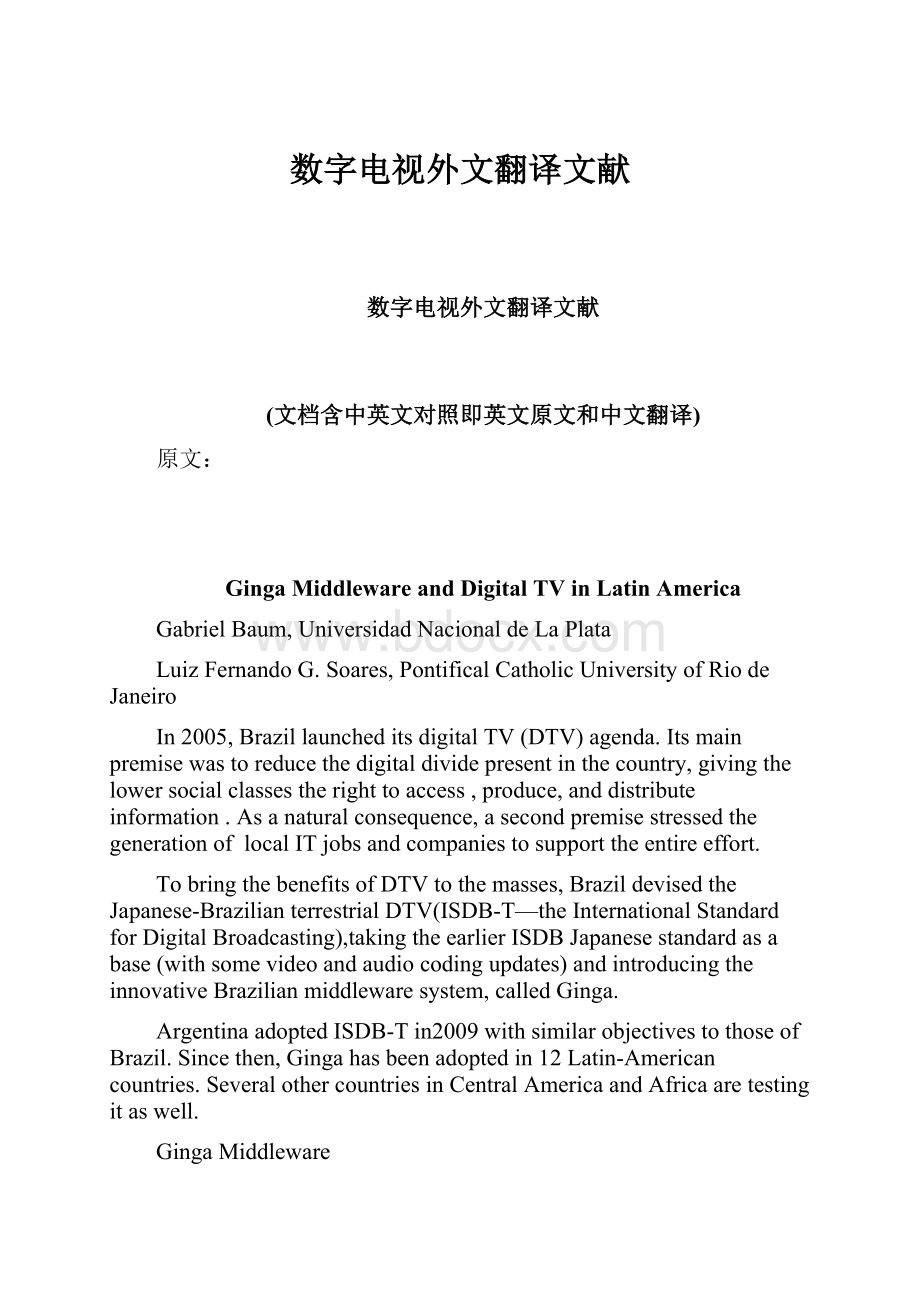数字电视外文翻译文献.docx
《数字电视外文翻译文献.docx》由会员分享,可在线阅读,更多相关《数字电视外文翻译文献.docx(10页珍藏版)》请在冰豆网上搜索。

数字电视外文翻译文献
数字电视外文翻译文献
(文档含中英文对照即英文原文和中文翻译)
原文:
GingaMiddlewareandDigitalTVinLatinAmerica
GabrielBaum,UniversidadNacionaldeLaPlata
LuizFernandoG.Soares,PontificalCatholicUniversityofRiodeJaneiro
In2005,BrazillauncheditsdigitalTV(DTV)agenda.Itsmainpremisewastoreducethedigitaldividepresentinthecountry,givingthelowersocialclassestherighttoaccess,produce,anddistributeinformation.Asanaturalconsequence,asecondpremisestressedthegenerationoflocalITjobsandcompaniestosupporttheentireeffort.
TobringthebenefitsofDTVtothemasses,BrazildevisedtheJapanese-BrazilianterrestrialDTV(ISDB-T—theInternationalStandardforDigitalBroadcasting),takingtheearlierISDBJapanesestandardasabase(withsomevideoandaudiocodingupdates)andintroducingtheinnovativeBrazilianmiddlewaresystem,calledGinga.
ArgentinaadoptedISDB-Tin2009withsimilarobjectivestothoseofBrazil.Sincethen,Gingahasbeenadoptedin12Latin-Americancountries.SeveralothercountriesinCentralAmericaandAfricaaretestingitaswell.
GingaMiddleware
ThemiddlewareliesbetweentheapplicationcodeandruntimeinfrastructuretoenablefastandeasydevelopmentofTVapplications.In2007,theBrazilianterrestrialDTVstandard2adoptedtheNestedContextLanguage3asitsdeclarativelanguage.Inthebeginningof2009,NCLanditsuseragent,Ginga-NCL,becamepartofISDB-TstandardsandoftheInternationalTelecommunicationUnion(ITU-R)BT1699Recommendation.Alsoin2009,NCLandGinga-NCLbecameanITU-TRecommendationforIPTVservices.4GingawasthefirstfreeDTVmiddleware.Ginga-NCLandNCLspecificationsareopensourceandroyaltyfree,independentofthedistributionnetworkused.NCLandGinga-NCLwereconceivedattheTeleMediaLabatPontificalCatholicUniversityofRiodeJaneiro(PUC-Rio)/Brazilandhavebeendesignedasajointeffort,includingLIFIALabatNationalUniversityofLaPlata(UNLP)/Argentina.
Requirements
Aimingatsocialinclusion,amiddlewaremustsupportTV(“T”)applicationssuchasT-learning,T-government,andT-health.However,socialinclusionisreachednotonlybyofferingaccesstoinformationbutalsobyprovidingknowledgeabouthowtogenerateinformation.Therefore,aDTVsystemshouldofferauser-friendlylanguagefordesigningapplicationsandservices.Thislanguageshouldbesimpleenoughtobeunderstoodandlearnedbynonexperts.Moreover,itshouldbelightweight,becauseitsinterpretermustruninlow-costreceiverswithlimitedresources.However,itshouldalsobepowerfulenoughtosupportcreativity.
Thisneedforasimple,lightweight,andexpressivelanguageledtoadeclarativedomain-specificlanguage(DSL)forTVapplicationdesign,inwhichthecomplexalgorithmicstepstoaccomplishataskarelefttothemachineandaren’tunderuserresponsibility.Thefocusonmediasynchronization(initsgeneralaspect—havinginteractivityasaparticularcase),contentandpresentationadaptability,supportformultipledeviceexhibitions,andsupportthatwouldalsoallowforgeneratingliveDTVapplications,weretherequirementsthatguidedtheNCLdesign.
Architecture
Gingawasinitiallyproposedforterrestrialtems,butthesamearchitectureandfacilitieswerelaterappliedtoIPTV.
Figure1.TheGingaarchitecture:
(a)thegeneralarchitectureand
(b)optionalextensions.
Furthermore,themodulararchitectureofGingaalsoallowsforitsusewithothertransportsystems(suchassatelliteandcableTV),dependingonlyonitsGingaCommonCore(Ginga-CC)subsystem.Figure1adepictstheGingacomponentsandhowtheyrelatewithothercomponentsofageneralDTVarchitecture.
TheGinga-CCsubsystemdeliversapplicationstoGinga-NCL.TheGinga-NCLpresentationengineisthelogicalsubsystemresponsibleforrunningNCLapplications.TheGingaarchitecturealsooffersoptionalextensions(seeFigure1b).Forexample,forterrestrialDTVsystems,theGinga-Jexecutionengine(requiredforfixedreceiversandoptionalforportablereceiversinBrazil;andoptionalforallkindofreceiversinArgentina)isresponsibleforrunningJavaDTVapplications.ConnectedorBroadbandTVmightalsodefinesomeextensionstoimplementservices,suchasElectronicProgramGuidesandwidgets.IPTVspecificservices,suchasvideoondemand,datacasting,andsoon,areexamplesofotherpossibleextensions.GingaoffersNCLservicestoallextensionsthroughawell-definedAPI.
Ginga-NCLhasanopensourceGPLreferenceimplementation(www.softwarepublico.gov.br)recognizedbyITU-T.Someopensourceproductshavebeenderivedfromthisimplementation,includingLIFIAmiddleware(ginga.ar)forset-topboxes(http:
//tvd.lifia.info.unlp.edu.ar/ginga.ar)andNokiamiddlewareformobilephones(48850?
clickSource=search&pos=2).TherearealsosomeotherproprietaryGingaimplementations.AlthoughtherearemanyGingaimplementations,somestillworrythatamonopolycouldbecreatedforthemarketofGinga,mainlyresultingfromitspossibleextensions.Thisshouldbestronglyopposed.
Impact
GingahashelpedcreatemanyjobsandITcompaniesinBrazil—atleast13smallandmedium-sizesoftwarecompaniesand60serviceproviders.TVmanufacturershavebeenmerelyassemblersofmultinationalcompaniesinthecountry,butnowthey’reobligedtoestablishlocaldevelopmentsectionstoincorporatethetechnologicalinnovationsbeingcreated.AsforBrazilianprivate(commercial)broadcasters,they’renotcommittedtosocialinclusion.Ofcourse,thisscenariocausessometensions,whichcanonlybeovercomewithastrongandresponsiblegovernmentpolicyandstrongtechnicalsupportfromacademia.
InArgentina,aroundadozencompanieshaveshowninterestindevelopingapplicationsorservicesbasedonGinga,andsomehavedevelopedproducts.Inaddition,someacademiclaboratories—mainlyLIFIAandtheUniversityof3deFebrero,withthesupportoftheMinistryofFederalPlanning—havedevelopedtechnologicalinnovationsandinteractiveapplicationsbasedonGinga.IfArgentinacanturnLIFIA’s“ginga.ar”freeimplementation(basedonthePUC-Rio’sreferenceimplementation)intoadefactoproduct,thenitcanprovideaplatformonwhichITcompaniescoulddevelopnewproductsandservices.
ContentDistribution
Therighttodistributecontentisanimportantcomponentofsocialinclusion,yetprivate(commercial)broadcasterswon’ttransmitsocialthird-partycontentforfree.Perhapsstateandfederalgovernmentscouldpayforsometransmissionsoflarge-scaleinterest,butindependentproducers,suchascommunityTVprogrammers,can’taffordtodistributetheircontent.Publicbroadcastingcouldbeasolution.AlthoughtheprocessofdigitalizationforpublicbroadcastersinBrazilisbehindschedule,theprocesshascurrentlystarted,sothere’shope.
TheArgentinianprogramisheavilybasedonpublicmedia,suchasPublicTVandotherchannelslike“Encuentro”and“INCAATV.”Althoughseveralprivatebroadcastershavejoinedtheinitiative,theproductionofcontentisbeingledbythefederalgovernment,promotingtheproductionofcontenttostrengthenanddemocratizecommunication.
Nevertheless,anotheralternativefordemocratizingcontentdistributioncomesfromIPnetworks—inparticular,theInternet(seewww.iptv.brinitiative).GingaisaninternationalstandardnotonlyforterrestrialDTVbutalsoforIPTVservicesandthusforhybridDTV.
Ginga-NCLcanembedlanguageplayersbutcanalsobeembeddedinotherlanguageplayers—forexample,actingasaplug-inforHTML-5browsers.AnNCLapplicationcanbeembeddedinanHTMLapplicationand,atthesametime,itcanembedanotherHTMLapplication.AworkinthisdirectionhasjustbeenfinishedforFirefoxandChrome;andhasalreadybeenstartedforHBBTV(HybridBroadcastBroadbandTV)andLIME/BML(LightweightInteractiveMultimediaEnvironment).
SeveralissuesareunderconsiderationforthenextgenerationoftheNCLlanguage,suchashigh-levelabstractionsfordefiningrelationships,bettersupportforcontext-awareapplications,andsupportformultimodalinteractionsand3Dobjects.NovelissuesforGinga-CCarealsobeingconsideredtokeepGingaasacompetitiveDTVmiddlewareintheworldmarket.
References
1.L.F.G.Soares,R.F.Rodrigues,andM.F.Moreno,“Ginga-NCL:
TheDeclarativeEnvironmentoftheBrazilianDigitalTVSystem,”J.BrazilianComputerSoc.,vol.12,no.4,2007,pp.37–46.
2.ABNTNBR15606-2,Ginga-NCLforFixedandMobileReceivers—XMLApplicationLanguageforApplicationCoding,2nded.,BrazilianNat’lStandardsOrganization,2011.
3.L.F.G.Soaresetal.,“Ginga-NCL:
DeclarativeMiddlewareforMultimediaIPTVServices,”IEEEComm.Magazine,vol.48,no.6,2010,pp.74–81.
4.NestedContextLanguage(NCL)andGinga-NCLforIPTVServices,ITU-TRecommendationH.761,Apr.2009.
GabrielBaumisaprofessorofinformaticsattheUniversidadNacionaldeLaPlata.Contacthimatgbaum@sol.lifia.info.unlp.edu.ar.
LuizFernandoGomesSoaresisafullprofessoratthePontificalCatholicUniversityofRiodeJaneiro.He’salsothemainarchitectofGinga,co-editoroftheITU-TH.761RecommendationforIPTVServices,andchairoftheBrazilian
译文:
银河中间件和在拉美地区的数字电视
Gabriel鲍姆大学国立deLaPlata
LuizFernandoG.Soares,教廷天主教大学的里约热内卢
2005年,巴西推出数字电视(DTV)议程。
其主要的前提是减少数字鸿沟存在于该国,给有权访问,生产,和分发信息的更低的社会阶层。
作为一个自然的后果,第二个前提强调代当地就业机会和公司支持的整个努力。
为了给群众带来数字电视的好处,巴西制定日本巴西地面数字电视(ISDB-T——国际标准针对数字广播)、以早些时候ISDB日本标准作为基础(与某些视频和音频的编码更新)和引进创新的巴西中间件系统,称为银河。
阿根廷通过与目标类似于那些巴西ISDB-T2009年。
从那时起,银河已在12个拉丁美洲国家。
几个中美洲和非洲其他国家以及正在测试它。
银河中间件
中间件介于应用程序代码和运行时基础结构,使电视应用程序快速、简单地开发。
2007年,巴西的地面数字电视standard2通过嵌套上下文Language3作为其声明性语言。
在2009年年初,N